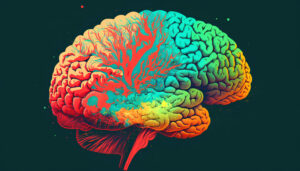Stress is our natural response to a situation or event that we perceive as challenging, even threatening. Stress is good insofar as it motivates us to take positive action or prompts us to adapt to a threat. But it can become harmful when we lack the confidence or ability to adapt in a healthy way.
When we lack either the confidence or tools to adapt to stress, we experience symptoms like anxiety, impatience, worry, dread, fear, irritability, anger, depression, and so on. We become susceptible to illness. Or we may even engage in harmful, distracting, or addictive coping behaviors.
To better understand stress, it’s helpful to know something about how the brain works. The brain is made up of three main systems: The brain stem, the limbic system, and the cerebral cortex.
The Brainstem
The brainstem is the lowest part of the brain and connects to the spinal column. It’s the most primitive part of the brain and responsible for regulating the body’s automatic functions like breathing, heartrate, blood pressure, blinking, digestion and even balance, coordination, and reflexes. This part of the brain is sometimes referred to as the reptilian brain.
The Limbic System
The limbic system makes up a second part of the brain. It resides in the center of the brain between the brainstem and cerebral cortex. Although complex and made up of many different parts, the limbic system is the seat of our emotions and motivation as well as learning and long-term memory storage and retrieval.
One prominent structure in the limbic system is the amygdala, which is a pair of small, almond-shaped structures located in the brain’s left and right temporal lobes. The amygdala is considered the emotion center of the brain and processes feelings like pleasure, fear, anxiety, and anger.
Another structure of the limbic system is the hippocampus which also comes as a pair and resembles the shape of a curvy seahorse and is considered the memory center of the brain.
The Cerebral Cortex
The third part of the brain is the cerebral cortex or outer shell of the brain that is the seat of conscious thought, logic, and reason. A critical structure of the cerebral cortex is the prefrontal cortex (PFC) which sets just behind the forehead. If the brain is the headquarters of the body, then the prefrontal cortex is the CEO.
The prefrontal cortex carries out the executive functions of the brain by organizing, judging, predicting, planning, problem-solving, and initiating action. It also keeps the impulses and emotions that arise from the limbic system in check so we can functional effectively. When the PFC is working well, we’re able to consider consequences and think before we act. However, this part of the brain is slow to develop and doesn’t reach full development until our mid-twenties which is one reason those teen years can be so turbulent.
Upstairs and Downstairs
As I think about the brain, I like a distinction that Dan Seigel uses to differentiate between the limbic system and cerebral cortex. He calls the limbic system, that system responsible for our emotional reactions, the downstairs brain, and the cerebral cortex, responsible for reason and executive functions, the upstairs brain. And he describes them as connected by a metaphorical staircase which enables the upstairs brain to monitor and even calm the strong emotions and impulses of the downstairs brain. When working well, the staircase enables us to incorporate messages from the downstairs brain into our thinking and planning so we can determine a good course of action.
The Consequences of High Stress
But what sometimes happens during times of high stress is that the downstairs brain overrides the upstairs brain. The amygdala, which is designed to keep us safe from harm, is continually scanning for danger. The amygdala activates our fight or flight response when it perceives danger. This, in turn, activates the sympathetic nervous system, which triggers the release of adrenaline and other stress hormones into the bloodstream to respond to the danger. These hormones increase our heart rates, dilate our pupils, and stimulate the release of glucose from the liver to provide our bodies with energy to respond to the threat.
This is all good and necessary to prepare our minds and bodies to deal with real threats and challenges. Thanks, amygdala. But the problem, in these modern times, is that this fight or flight response can be triggered in situations that are not actually life-threatening. There is no tiger in the room and yet our brains and bodies act as if there is. Or, if we’re dealing with chronic or ongoing stressors, then our brains manufacture an overabundance of hormones, particularly cortisol. These chemicals not only cause us to over-react to what’s happening but literally do damage to our organs and disrupt our brain’s longer-term ability to process information efficiently.
The truth is that in normal, everyday life, we’re not in mortal danger even though our minds and bodies may overreact to what is happening. We need to find ways to calm our minds and bodies so we can think and act reasonably and with sound judgement. That is the goal of stress management, to calm your downstairs brain so that the cerebral cortex can respond to the stress in an effective way.
What Do You Do?
So let me ask. Are you aware of those times (key moments) when your downstairs brain perceives danger and begins to react through fight or flight? What is your typical response? And what strategies or techniques do you use to calm yourself in these circumstances?
Share a thought below.

